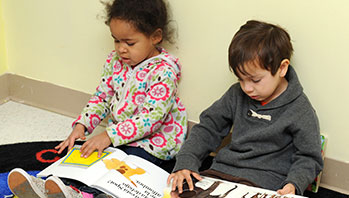-
The Listening Walk (book)
- noise
- sound
- still (v.)
- whisper
MA Standards:
Literature/RL.PK.MA.6: With prompting and support, “read” the illustrations in a picture book by describing a character or place depicted, or by telling how a sequence of events unfolds.
Literature/RL.PK.MA.4: With prompting and support, ask and answer questions about unfamiliar words in a story or poem read aloud.
Head Start Outcomes:
Literacy Knowledge/Book Appreciation and Knowledge: Asks and answers questions and makes comments about print materials.
Language Development/Expressive Language: Engages in conversations with peers and adults.
PreK Learning Guidelines:
English Language Arts/Reading and Literature 6: Listen to a wide variety of age appropriate literature read aloud.
English Language Arts/Reading and Literature 10: Engage actively in read-aloud activities by asking questions, offering ideas, predicting or retelling important parts of a story or informational book.
One-on-One Reading: The Listening Walk #3

© Commonwealth of Massachusetts, Department of Early Education and Care (Jennifer Waddell photographer). All rights reserved.
Skill Focus: Concepts of Print, Identifying Sounds, Recall and Retell, Speaking and Listening, Story Comprehension, Vocabulary
Read aloud The Listening Walk by Paul Showers to individuals or small groups. As you read:
- Explain the meaning of unfamiliar words such as brave, different, noise, steady, still (v.), and whisper.
- Pause occasionally to help children make connections to the book. For example, while reading pages 12–13, talk about the different sounds the cars are making. Say, One is making a soft, “hmmmmm” sound, and another has screeching brakes that go “eeeeeeeee.” Ask children if they can imitate any other sounds a car makes.
- Encourage children to talk about the illustrations and tell what they think is happening in the story. For example, What sounds do you think the lawn mower makes? Encourage children to use sound words to describe the scene.
English Language Learners: Review vocabulary from the read-aloud book with children. Point to objects from the book, if available, and have English Language Learners say the name of the object in their home language. Repeat the word they say, then have them say the name of the object in English after you.
